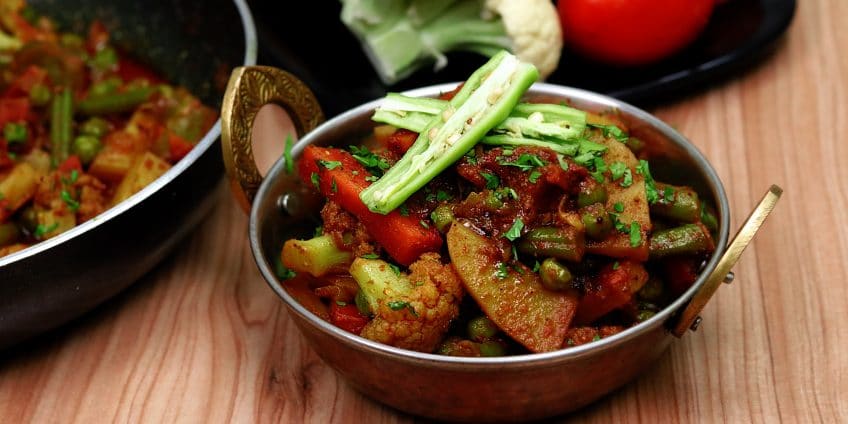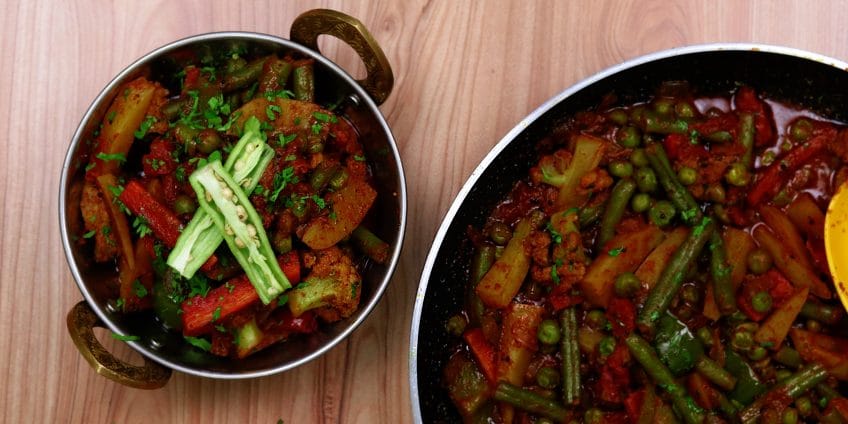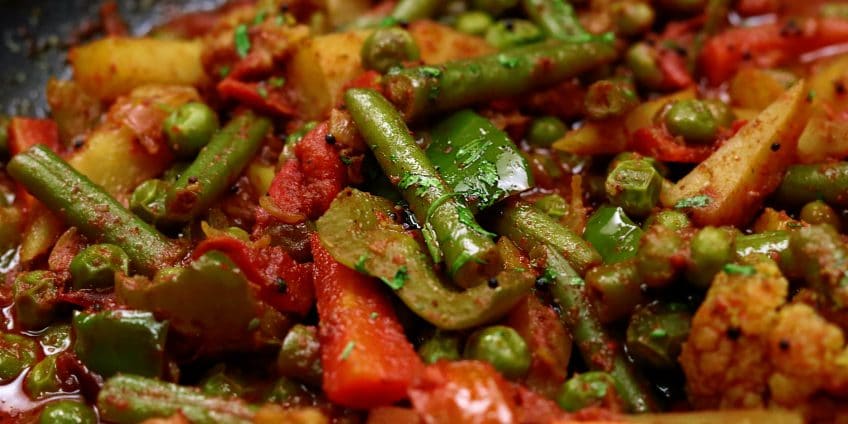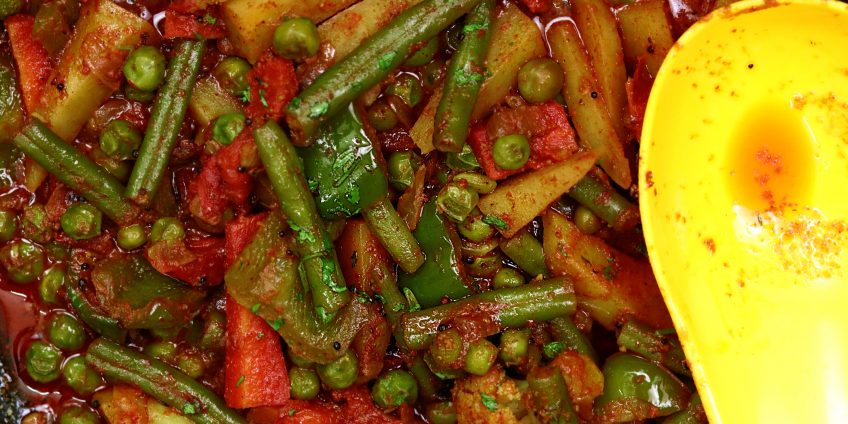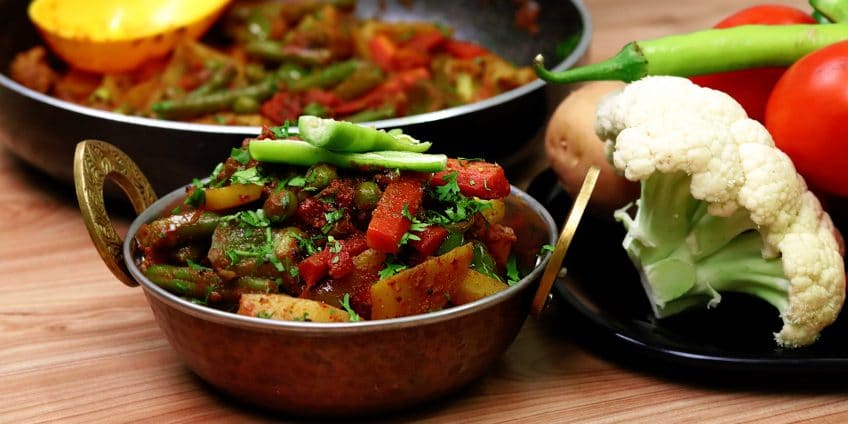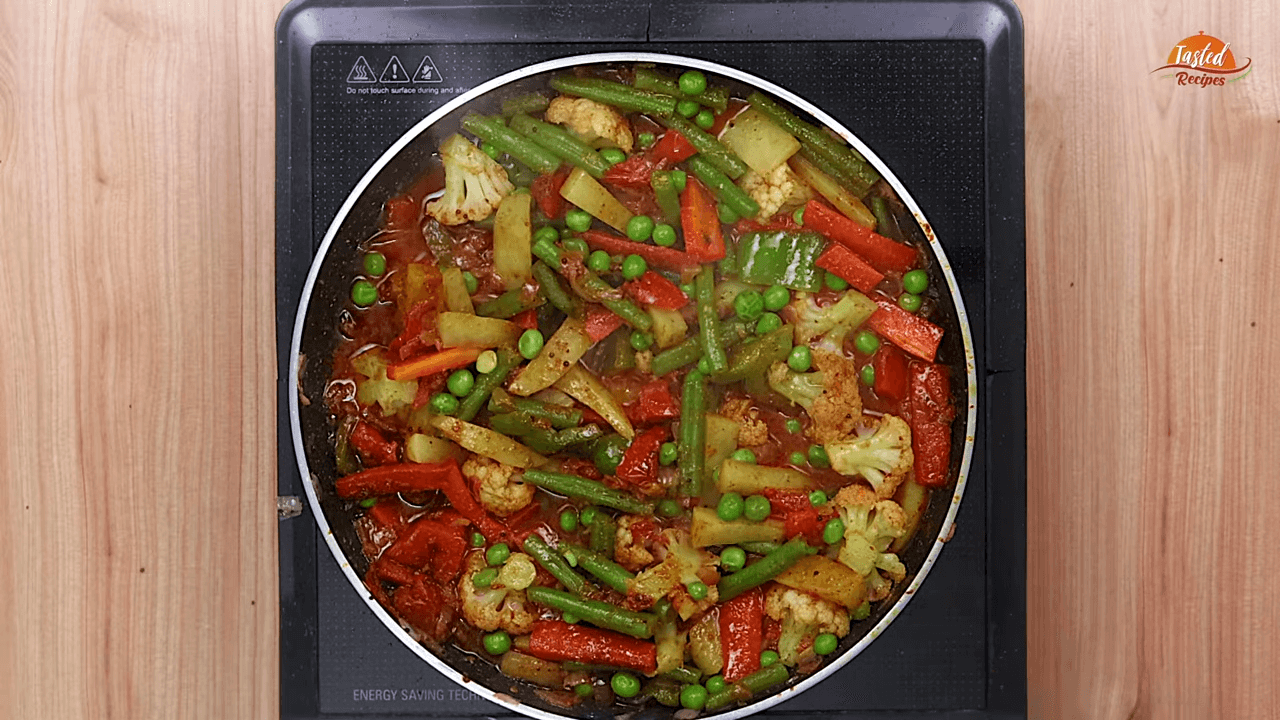Veg Kolhapuri is a vegetable dish from Maharashtra. This dish is nutritious, flavorful, delicious, and high on spices.
As the name suggests, this recipe is originally from the Kolhapur region of Maharashtra. However, you will find this dish in many restaurants offering Punjabi dishes with their twists with it. Serve the dish with naan, roti, garlic naan. It is a great recipe for lunch and dinner.
Vegetables we used
This recipe is full of vegetables. It also makes the dish a highly nutritious one. There are no set rules as to which vegetable to use, though. Yes, you can do as many as you want and whichever vegetable you like to eat. This recipe is flexible like that.
Avoid using vegetables like spinach as it is high in water content and can make the final result watery. Stirfry cabbage will do, however.
Whole Dry Spices
In our recipe, there is only black mustard seeds and nothing else. It is because we are not using any whole spices. Using Kolhapuri masala, adding more whole spices will be too much. The flavours will be overpowering. Therefore, any whole spice is absent here.
However, you can add them if you like star anise, bay leaves, cinnamon, nutmeg, cloves, coriander seeds, black cardamom, or pepper are all great. That depends on you.
2 Different Restaurant Styles to Make Veg Koplhapuri
A few dishes on a restaurant’s menu are always ready and are served in minutes. Veg Kolhapuri is one of them. To make that possible, they prepare a few things beforehand. We have done something different because it will be a little more lengthy than ours.
The first step is to saute all the vegetables in some oil. We saute cauliflower first and preferably separately. After that, we can saute the remaining veggies together. If you don’t want to do this, then blanch the vegetables. But sauteeing them would be better than blanching for a better flavour. So we are simply boiling everything.
Other steps will be to make the gravy base. We have directly added the Kolhapuri masala, but you can make the base if you don’t have that. To do that, sauteed all the dry spices dry red chilli (and grated coconut if you are using that). Then, make a paste of them. Also, make a paste of tomatoes and boiled cashews (melon seeds if included).
Lastly, saute cumin seeds, bay leaves, and dry red chillies. Cook onions until slightly brown, add chopped green chillies and spices. Also, add the spices gravy with water. Cook till oil separates. Then add the tomato & cashew paste. If you want, you can add Kashmiri red chilli paste. Finally, add all the vegetables and mix with some water. If you are adding paneer, add it at last. Cook a bit and garnish with chopped coriander, then serve.
TR’s Extra Shots
- Chilli – We are not using dry red chillies here. Generally, this recipe includes Bedgi Mirchi, which also brings a nice red colour to the dish.
- Soaking – If you are using the chillies, make sure to soak them in warm water to bring out the colour.
- Masala – There is an option of using Kanda Lahsun masala in this recipe. It is available in the market quickly.
- Steaming – If you don’t have much time or do not wish to spend too much time, then you can steam the vegetables in a steamer if you have that.
- Vegetables – We are, as it is, using enough vegetables. You can add more to it like potatoes, baby corn, mushrooms. Paneer is also a good option for adding. If you use fresh peas instead of frozen ones, you need to boil them.
- Texture – You can do one thing if you want to add a more prosperous and smoother texture. Add cashew and melon seeds paste. Just cashew will do as well.
- Flavours – You can add Kashmiri red chilli paste for brighter colour and flavour. Add some lemon juice as well for some tanginess. Of course, you can buy any other readymade masala powder or garam masala powder to it as well. Do not overdo, though.
- Tomato Paste – You can make a paste of tomatoes and cashews, and seeds if you are using them. But you can also saute garlic & onions until the onions are slightly caramelized and add them to make a paste.
Frequently Asked Questions
Is Veg Kolhapuri too spicy?
This dish is well known for being spicy. The major spiciness comes from dry spices and local masalas instead of chillies. You can level the spices as per your taste.
How can I reduce the spiciness after cooking?
If you find the dish too spicy after cooking it, you can add heavy cream or curt/yoghurt to adjust that. It will change all the flavours in the dish. Be careful not to add too much, or you’ll lose all the flavours.
What not to add if using Kanda Lahsun masala?
If you use the local Kanda lahsun masala in this dish, skip using the kolhapuri masala. You can double the measure for that; then you use kolhapuri masala.
There was a tinge of bitterness in the end. How to correct that?
You might use poppy seeds, sesame seeds that are no longer fresh and past their shelf life hence not edible. Or it could happen that black mustard seeds may not have popped completely. If this happens, then you can use heavy cream. Or better, use no more than 1/2 cup of milk and simmer the dish.
Can I use premade and stored dry spices mixture?
You can do so. But the proportions of the flavours will also be disturbed, and the final taste may not be suitable as you will be straying from the measure shown. So it is recommended to stick to the suggested proportions.
Can I replace kolhapuri masala with goda masala?
Both the kolhapuri masala and goda masala are from Maharashtra. However, we don’t recommend Goda masala instead of kolhapuri masala. Kolhapuri dishes is on the spicier side, and hence kolhapuri masala is also spicy.
But goda masala is not spicy but has a sweet undertone. This is because Goda masala does not include onion and garlic present in kolhapuri masala. Hence you will get a mild flavour and a tad sweet if you use Goda masala.
Can Maharashtrian Malvani Masala replace the dry spices powder?
Malvani masala is very flavorful and contains many spices like dry red chillies, peppercorns, star anise, coriander seeds, cumin seeds, cloves, cinnamon, fennel and cardamom.
Since the whole spices used in this recipe is flexible and Malvani masala provides a similar taste to kolhapuri masala, more or less, This can be a substitute.
Some more recipes:

